
The genus Catharus is an evolutionary clade of forest-dwelling passerine birds in the family Turdidae (thrushes), commonly known as nightingale-thrushes. The extant species are widely distributed across the Americas and are descended from a common ancestor that lived 4–6 million years ago. Most of the species are shy of humans, seldom leaving the cover of dense forest vegetation, where their activities are hidden from view. Thus, many fundamental aspects of their biology and life histories are poorly known.
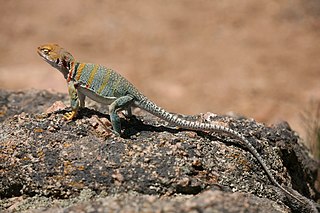
The Crotaphytidae, or collared lizards, are a family of desert-dwelling reptiles native to the Southwestern United States and northern Mexico. Alternatively they are recognized as a subfamily, Crotaphytinae, within the clade Pleurodonta. They are very fast-moving animals, with long limbs and tails; some species are capable of achieving bipedal running at top speed. This species is carnivorous, feeding mainly on insects and smaller lizards. The two genera contain 12 species.

The Iguanidae is a family of lizards composed of the iguanas, chuckwallas, and their prehistoric relatives, including the widespread green iguana.

The genus Brachylophus consists of four extant iguanid species native to the islands of Fiji and a giant extinct species from Tonga in the South West Pacific. One of the extant species, B. fasciatus, is also present on Tonga, where it has apparently been introduced by humans.

Fringe-toed lizards are lizards of the genus Uma in the family Phrynosomatidae, native to deserts of North America. They are adapted for life in sandy deserts with fringe-like scales on their hind toes hence their common name.

Urosaurus is a genus of lizards, commonly known as tree lizards or brush lizards, belonging to the New World family Phrynosomatidae. They are native to North America, specifically the arid and semiarid regions of the western United States and Mexico, spending most of their time on trees, shrubs, or boulders.
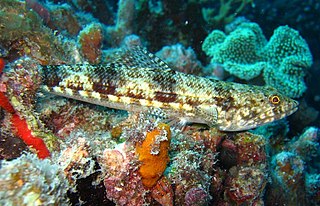
Aulopiformes is a diverse order of marine ray-finned fish consisting of some 15 extant and several prehistoric families with about 45 genera and over 230 species. The common names grinners, lizardfishes and allies, or aulopiforms are sometimes used for this group. The scientific name means "Aulopus-shaped", from Aulopus + the standard fish order suffix "-formes". It ultimately derives from Ancient Greek aulós + Latin forma, the former in reference to the elongated shape of many aulopiforms.

The Coachella Valley fringe-toed lizard is a species of phrynosomatid lizard.
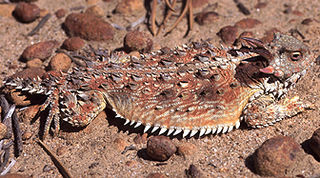
The coast horned lizard is a species of phrynosomatid lizard endemic to Baja California Sur in Mexico. As a defense the lizard can shoot high pressure streams of blood out of its eyes if threatened.
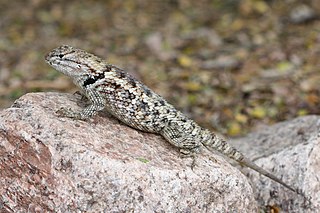
Sceloporus magister, also known as the desert spiny lizard, is a lizard species of the family Phrynosomatidae, native to the Chihuahuan Desert and Sonoran Desert of North America.

Holbrook's southern dusky salamander, previously known as just the southern dusky salamander, is a species of salamander endemic to the southeastern United States. Older sources often refer to it as the eared triton. Formerly abundant, it has precipitously declined since the 1960s.

Diploglossidae is a family of anguimorph lizards native to the Americas, with most genera being endemic to Hispaniola. Most members of this family are known as galliwasps. They were formerly considered a subfamily of Anguidae, but genetic evidence has shown them to be less closely related to other members of Anguidae than Anniellidae is.

The Mojave fringe-toed lizard is a species of medium-sized, white or grayish, black-spotted diurnal lizard in the family Phrynosomatidae. It is adapted to arid climates and is most commonly found in sand dunes within the Mojave Desert. Fringe-toed lizards are characterized by their fringed scales on their hind toes which make locomotion in loose sand possible.

The Balkan crested newt or Buresch's crested newt is a newt species of the crested newt species complex in genus Triturus, found in Southeastern Europe and Anatolia.

Sceloporus uniformis, also known as the yellow-backed spiny lizard, is a reptile of the family Phrynosomatidae. It is native to the Mojave and Great Basin deserts. Until recently, it was considered to be a subspecies of Sceloporus magister.

The Selenocosmiinae are a subfamily of tarantulas found throughout South-East Asia and Australia. This subfamily is defined by the presence of a lyra on the maxillae and strikers on the chelicerae, allowing these spiders to stridulate and produce a "hissing" sound. However some species within Phlogiellus may have secondary lost their lyra but retain their strikers. The monophyly of the subfamily has been only tested using genetic data with a handful of genera or species in a few studies. However, these studies found genera that had been previously placed in this subfamily were actual their own separate subfamily (Poecilotheria) and that Selenocosmiinae is most closely related to the Indian Thrigmopoeinae. As of 2021, Selenocosmiinae contains 11 genera.

The Colorado Desert fringe-toed lizard is a species of medium-sized, diurnal lizard in the family Phrynosomatidae. It is adapted to arid climates and is most commonly found in sand dunes within the Colorado Desert of the United States and Mexico.

The southwestern red squirrel or Fremont's squirrel is a species of tree squirrel endemic to high-altitude regions of the southwestern United States.
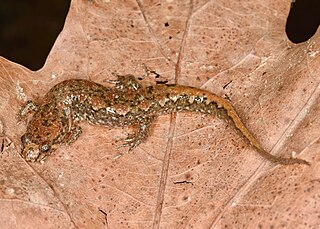
The spotted dusky salamander is a species of salamander in the family Plethodontidae. It is endemic to the United States.

The Yuman Desert fringe-toed lizard is a species of phrynosomatid lizard endemic to northwestern Mexico, although a hybrid population of it and Uma notata ranges north to southwestern Arizona in the United States.



















